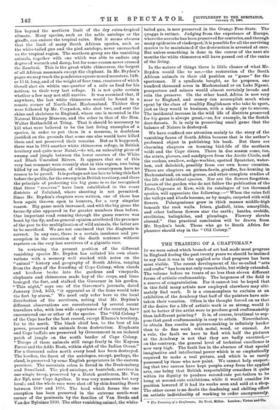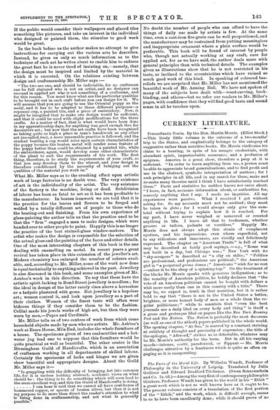THE TRAINING OF A CRAFTSMAN.* The other cause is no
doubt the deadening and chilling effect
IP we were asked which branch of art had made most progress in England during the past twenty years we should be inclined to say that it was in the applied arts that progress has been most visible. The recent development of the so-called "arts and crafts" has been not only remarkable, but widely extended. The volume before us treats of no less than eleven different forms of artistic craftmanship. The largeness of the field is a source of congratulation. For it cannot but be hoped that in this field many artists now employed elsewhere may ulti- mately find work. It is a commonplace to exclaim at an exhibition of the Academy that half of the painters have mis- taken their vocation. Often is the thought forced on us that if the desire for a life of artistic work is so strong, would it not be better if the artist were to produce good craftsmanship than indifferent painting P It is, of course, irrational to sup- pose that good craftsmanship is easy to attain. Nevertheless, to obtain fine results in picture-making is infinitely harder than to do fine work with metal, wood, or enamel. As a rule, the fault we have to find with half the pictures at the Academy is not that they are badly executed,— on the contrary, the general level of technical excellence is now very high. The fault lies in the absence of that special imaginative and intellectual power which is so emphatically required to make a real picture, and which is so rarely possessed by those who now paint. We cannot help suspect- ing that two causes have kept people., away from the applied arts, one being that British respectability considers it quite within its dignity to produce second-rate pot-boilers to be hung at second-rate exhibitions, while it would consider its position lowered if it had its works seen and sold at a shop.
If the public would consider their wallpapers and glazed tiles something like pictures, and take an interest in the individual who designed or painted them, the stimulus to good work would be great.
In the book before us the author makes no attempt to give instructions for carrying out the various arts he describes. Instead, he gives us only so much information as to the technique of each art he writes about to enable him to enforce the great fact he is never tired of insisting on,—namely, that the design must be inspired and limited by the material in which it is executed. On the relations existing between design and craftsmanship Mr. Miller says :—
"The two are one, and should be indivisible, for no craftsman can be full statured who is not an artist, and no designer can succeed in applied art who is not something of a craftsman, and for this reason. You must know what are the particular qualities to be brought out in each craft before you can design for it. We will assume that you are going to use the Oriental poppy as the motif, and it has to be adapted to three different purposes—a repousse cup, a painted tile, and a piece of embroidery. Now, it might be imagined that to make one design would be sufficient, and that it could be used with slight modifications for the three crafts. As a matter of fact, that is what would have been done in my apprenticeship days, for anything was good enough then for decorative art; but now that the art crafts have been recognised as taking quite as high a place in man's handiwork as any other art (so-called fine), a more reasonable practice is followed, and the student beating a cup would seize upon certain characteristics of the poppy because the beaten metal will render some feature of the poppy better than could be obtained by a painted tile, while the embroiderer, again, would develop some other characteristic of the plant to suit the requirements of his work. The first thing, therefore, is to study the requirements of your craft, so that you may develop them to the utmost, and your design is therefore conditioned by the necessity of bringing out the qualities of the material you work in."
What Mr. Miller says as to the crushing effect upon artistic work of large factories is no doubt true. The very existence of art is the individuality of the artist. The very existence of the factory is the machine, living or dead. Subdivision of labour has been as fatal to art as it has been profitable to the manufacturer. In beaten ironwork we are told that it is the practice for the leaves and flowers to be forged and welded by a totally different set of people to those who do the beating-out and finishing. From his own experience of glass-painting the author tells us that the practice used to be that the " firm " engaged a man to make designs, whiah were handed over to other people to paint. Happily this is no longer the practice of the best stained-glass window-makers. The artist who makes the design is responsible for the selection of the actual glass and the painting of the faces and other details. One of the most interesting chapters of this book is the one dealing with enamelling on metal. In recent years a great revival has taken place in this extension of the jeweller's art. Modern chemistry has enlarged the number of colours avail- able, and, according to Mr. Miller, some of the work now done is equal technically to anything achieved in the past. Jewellery is also discussed in this book, and some examples given of Mr. Ashbee'a work in this direction. To say that these have the artistic spirit lacking in Bond Street jewellery is needless ; for the ideal in design of the latter rarely rises above a horseshoe or a tadpole plastered with gems. But jewellery is a hopeless art; women control it, and look upon jewellery as a part of their clothes. Women of the finest taste will often wear hideous things if they consider them to be the fashion. Cellini made his jewels works of high art, but then they were worn by men,—Popes and Cardinals.
Mr. Miller tells as of two centres of work from which come household objects made by men who are artists. Mr. Ashbee's work at Essex House, Mile End, includes the whole furniture of a house. The specimens given of two coal-scuttles and a hot- water jug lead one to suppose that this furniture would be quite practical as well as beautiful. The other centre is the Birmingham Guild of Handicrafts, which is an association of craftsmen working in all departments of skilled labour. Certainly the specimens of locks and hinges we are given show beautiful and appropriate designs. About the Guild
Mr. Miller says it—
"Is grappling with the difficulty of bringing Art into common life, for it is useless holding abstract, academic views on what should be : the thing is to do something which will soon lead to the more excellent way, and this the Guild of Handicrafts is doing. I can hear it said that we cannot all have coal-boxes of hammered copper, or spoons of beaten silver, but then it is not my purpose to do more than direct the reader's attention to what is being done in craftsmanship, and not what is generally possible." No doubt the number of people who can afford to have the things of daily use made by artists is few. At the same time, even a cast-iron fire-grate can be well proportioned, and the manufacturer may be restrained from putting meaningless and inappropriate ornament where a plain surface would be preferable. This book will be found of interest by people who, though not actually working at any craft, care for applied art, for as we have said, the author deals more with general principles than with technical details. The examples given as illustrations show that he is not restricted in his taste, or inclined to the eccentricities which have ruined so much good work of this kind. In speaking of coloured bas- reliefs we are surprised that Mr. Miller has not mentioned the beautiful work of Mr. Anning Bell. We have not spoken of many of the subjects here dealt with—wood-carving, book- binding, and others—but we refer our readers to Mr. Miller's pages, with confidence that they will find good taste and sound sense in all he touches upon.



















































 Previous page
Previous page